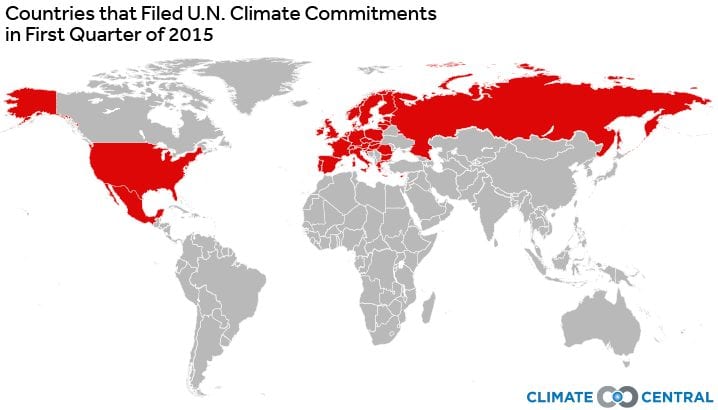An influential step in the years-long amble toward the most anticipated climate pact in nearly 20 years was taken on Tuesday. The U.S. informed the United Nations how it will fight global warming under a post-2020 agreement that’s due to be finalized during talks in Paris in December.
America’s dutiful filing of an administrative letter on Tuesday, detailing a type of commitment known by an unfamiliar acronym, produced no surprises. Yet it garnered a flurry of global media interest.
What Did The U.S. Just Do?
The State Department submitted a five-page document to the U.N. confirming that the nation plans to curb the amount of climate-changing pollution it releases every year by at least 26 percent by 2025, compared with 2005 levels. It said it would “make best efforts” to reduce pollution levels by more than that — by as much as 28 percent instead of 26.
In the document, the U.S. explained how it’s using the Clean Air Act and other laws to reduce climate pollution, such as through proposed rules affecting power plants. The government also wrote that it “does not intend” to utilize any international carbon markets to help it achieve the reductions. (Such markets tax pollution and are growing in number and size worldwide, largely because they can reduce the cost of climate action, but Congress remains opposed to them.)
The actual details of America’s INDC, or intended nationally determined contribution — as such climate commitments have been awkwardly named — were unsurprising. They were first announced by President Obama in the fall, following meetings with Chinese President Xi Jinping. After those meetings, Xi said his country would halt its annual growth in climate pollution by 2030. But the manifestation of Obama’s pledge as a formal document this week meant the U.S. was among the nations that met a soft deadline for submitting their INDCs.
How Soft?
Under the Lima accord, agreed upon during talks in Peru in December, nearly 200 countries plus the European Union extended an “invitation” to one another to file their INDCs “well in advance” of this winter’s Paris talks, or by March 31 for those countries “ready to do so.”
If The Deadline Was That Soft, Why Bother?
The U.S. and China are the world’s two biggest greenhouse gas polluters. In recent years, both countries have reversed years of institutionalized climatic apathy and begun taking the problem of climate change seriously. Those changes have underpinned a revival in global interest and confidence in ongoing U.N. climate talks. By meeting the soft March 31 deadline, the Obama Administration is telling the world that it remains committed to climate action and to the climate negotiations scheduled for Paris.
Who Else Met The Soft Deadline?
The star of climate action in a world bereft of climate action heroes is Europe, and the European Union submitted its INDC in early March. In it, the EU members committed to work together to reduce their overall loads of climate pollution by at least 40 percent by 2030, compared with 1990. Only Switzerland submitted its INDC before the EU, pledging in late February to reduce annual climate pollution by 50 percent by 2030, compared with 1990 levels. To do that, Switzerland said it might invest in projects that reduce pollution abroad.
During the past week, Norway submitted an INDC that resembled the EU’s, and Mexico became the first developing country to submit its commitment. On Tuesday, Russia filed its paperwork, indicating it would rely heavily on reforestation to reduce its climate impacts by 20 to 25 percent by 2030, compared with 1990 levels.
Major polluters that haven’t yet submitted their paperwork include China and India.
What Do Mexico And India Have In Common?
Mexico divided its INDC into two parts. Acting alone, it said its climate impacts in 2030 would be 25 percent lower than they were in 2000. But if it receives sufficient financial, technical and other help from more developed countries, it said its 2030 climate impacts could be shrunk to 40 percent below 2005 levels. India is expected to produce a similar INDC, saying what it could achieve alone, and what could be achieved with international climate financing — financing needed to help it meet ambitious commitments to build solar energy plants, among other things.
“They need rich countries to step up to provide finance for those deepening actions,” Heather Coleman, a senior climate change official at Oxfam America, which has been heavily involved in talks regarding climate financing under the upcoming Paris agreement, said. “It’s an important point that emerging economies and developing countries should be putting forward in their INDCs — what they can achieve with additional support.”
Is It Enough?
After all of the INDCs have been submitted, it’s very unlikely they will be enough, collectively, to keep global warming to below 3.6°F — which is the overarching goal of the international climate negotiations. The world is currently on track to emit enough greenhouse gases by about 2040 to exceed that target, beyond which the risks of “dangerous” consequences of global warming escalate, scientists say.
Experts caution against judging the Paris agreement by the sum of its parts, however.
By incorporating nearly all the world’s economies, and by doing so in ways that encourage and link together individual climate actions, the Paris agreement is being designed to provide an entirely new framework around which more ambitious climate commitments could be made in the coming years.
Source: Climate Central. Reproduced with permission.










